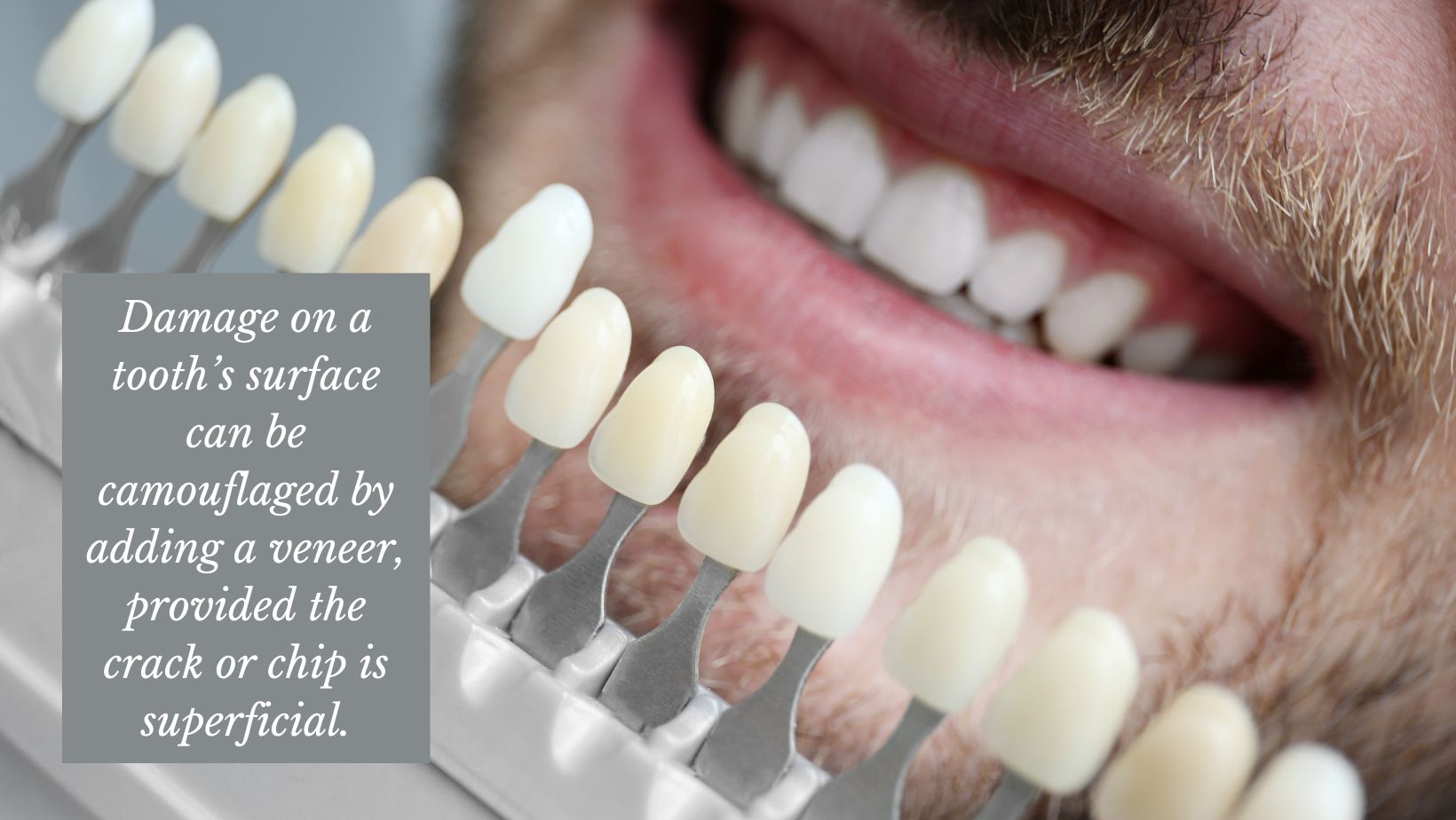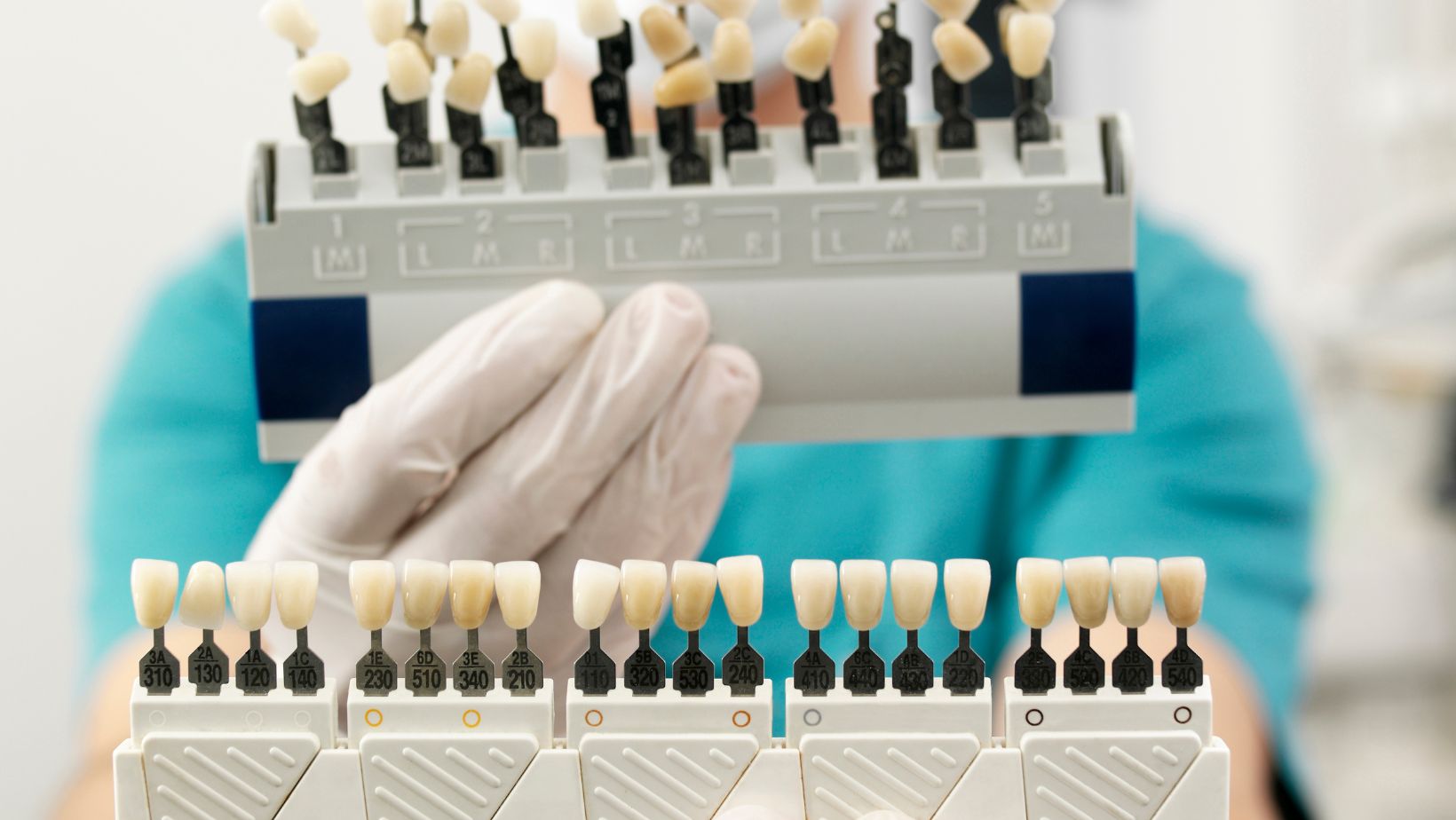When someone is unhappy with the appearance of a tooth, a cosmetic dentist can form a perfect-looking false front to cover it up. A dental veneer, made of porcelain or resin composite, might be just the solution to fix a damaged or discolored tooth.
When used as a verb, the word “veneer” means to “cover an object with any material that is more desirable as a surface material than the basic material of the object”. This is precisely what cosmetic dentists do when applying dental veneers.
Describing Dental Veneers
Dental veneers are sometimes compared to fake fingernails. Imagine someone who bites their nails down to the quick. A set of fake nails will disguise the chewed-up fingertips under a beautiful set that is uniform and perfectly shaped.
Dental veneers can do the same thing for an imperfect tooth…though with some important differences. Getting veneers involves undergoing a mildly-invasive process that permanently alters the tooth underneath.
For some, veneers are the perfect solution to a more perfect smile. Let’s take a look at answers to some questions, such as “How do dental veneers work?” and “Will they work for me?”
Problems Veneers Can—and Can’t—Solve
Veneers will conceal a number of cosmetic imperfections on the surface of teeth. This includes staining that regular teeth whitening won’t remove, chips or cracks, and irregularities of size and shape.
In fact, dental veneers work well for these issues:
Color correction: Tooth discoloration can come from many sources. Some stains are removable (for example coffee or tobacco) and some are not (those that are hereditary or from antibiotics like tetracycline). Instead of whitening treatments that need to be repeated, veneers will permanently change tooth color to the chosen shade.
Repairing Breaks: Damage on a tooth’s surface can be camouflaged by adding a veneer, provided the crack or chip is superficial. If a crack harms the root, or if bacteria has seeped in and formed a cavity, that will need to be fixed before placing a veneer.
Evening Out Odd Shapes: Few people are born with what might be considered “perfect” teeth, and sometimes nature will give us just one or two teeth that make an otherwise nice smile imperfect. A tooth might be pointed like a fang, much larger or smaller than its neighboring teeth, or turned at an angle. A veneer can provide a new face to covering these flaws.
Closing Spaces: Gaps between teeth might be fixed with braces, but sometimes, a dental veneer is a quicker, simpler option. The dentist simply creates a veneer that is slightly larger than the original tooth or teeth. Once in place, they extend the tooth surfaces to the proper width, closing the space between them.
How dental veneers work for all of these problems depends on how noticeable they are. A severely damaged tooth might require a crown or even an extraction and an implant instead. A dentist familiar with veneers can advise on what will work best for a patient’s specific issue.
Keep in mind that veneers will not fix tooth decay or cavities. They are not an alternative to a crown after a root canal. For missing teeth, patients might consider dentures or a dental implant, but a dental veneer will not help them. They will not straighten teeth like braces or other orthodontia, but in some cases, they can give the illusion of a more even smile.

How Do Dental Veneers Work?
After an initial consultation to determine if veneers are a good option, patients will have a thorough checkup to make sure the teeth are healthy. The actual process of getting veneers starts with x-rays, photos, and impressions of the teeth.
Patients can choose from porcelain or resin composite. Porcelain lasts longer but is more expensive. Many people feel that it looks most like a natural tooth because it is slightly translucent. Resin-composite is similar to the material used in fillings. It is more affordable, but may only last about 7 years, half the lifespan of porcelain. Porcelain is carved to match the natural contours that the tooth should have. Resin-composite can be sculpted by the dentist to look natural when put in place.
Part of veneers’ appeal is that they look like real teeth. For this reason, they do not all come in the same snowy white color. For both materials, patients are able to choose the exact shade that complements their hair and skin coloring. Their smile will be bright white, but also natural looking.
On the day of the procedure, patients get a local anesthetic so the teeth can be prepared without pain. The dentist scrapes off a portion of the tooth’s enamel. This makes the tooth’s surface rough so that the adhesive cement used to affix the veneer will stick. Temporary veneers allow the patient to eat and drink for the next two weeks while the veneers are created in a lab.
At the next appointment, the teeth are cleaned and polished and the dentist cements the permanent veneers into place.
After a few days of eating soft foods and treating them gently, the patient’s “new” teeth are ready for normal use.
Who is a Candidate for Veneers?
Dental veneers should only be placed on teeth that are reasonably healthy. Severely damaged teeth or a lot of tooth decay could rule someone out as a good candidate for the procedure.
The tooth’s structure must be strong enough to hold the veneer and also withstand the procedure of removing enamel and putting them in place. If there are cavities or the tooth needs a root canal procedure, that must be handled first.
The cost of veneers could rule them out as an option for some people. Because they are cosmetic, they are not covered by dental insurance. Porcelain veneers can cost between $900 and $2,500 per tooth. Resin-composite is less expensive with a range between $400 and $2,000. There are ways to reduce the cost of dental veneers, including payment plans, discounts, and even traveling to places with lower prices.
Finally, candidates for veneers need to understand how dental veneers work and that they are permanent. As we discussed above, there is a loss of some tooth enamel during the procedure. This means that if the veneer breaks or deteriorates, the process must be redone with a new veneer. The remaining tooth will be weakened and exposed to decay and further harm without a replacement.
Will Dental Veneers Work for You?
If you are interested in veneers, the first step is to discuss them with the dentist. They will be able to assess whether or not they are the right solution for your smile.
You can find a regular dentist or a cosmetic dentist who provides veneers in our online database. Just answer a few questions and we’ll help make your first appointment.


